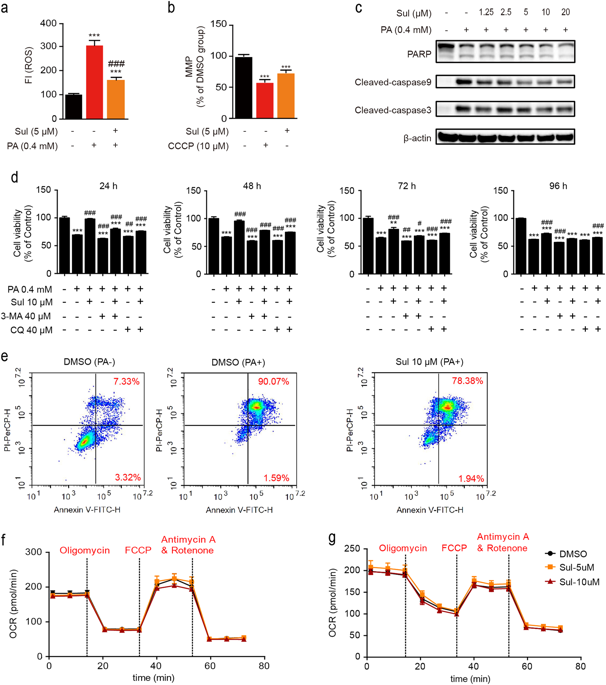当前位置:
X-MOL 学术
›
Acta Pharmacol. Sin.
›
论文详情
Our official English website, www.x-mol.net, welcomes your
feedback! (Note: you will need to create a separate account there.)
Sulfuretin protects hepatic cells through regulation of ROS levels and autophagic flux.
Acta Pharmacologica Sinica ( IF 6.9 ) Pub Date : 2018-12-18 , DOI: 10.1038/s41401-018-0193-5 Yu-Ting Lu 1, 2, 3 , Yu-Feng Xiao 1, 2 , Yu-Feng Li 1, 2 , Jia Li 1, 2, 3 , Fa-Jun Nan 1, 2 , Jing-Ya Li 1, 2
Acta Pharmacologica Sinica ( IF 6.9 ) Pub Date : 2018-12-18 , DOI: 10.1038/s41401-018-0193-5 Yu-Ting Lu 1, 2, 3 , Yu-Feng Xiao 1, 2 , Yu-Feng Li 1, 2 , Jia Li 1, 2, 3 , Fa-Jun Nan 1, 2 , Jing-Ya Li 1, 2
Affiliation

|
Palmitate (PA) exposure induces stress conditions featuring ROS accumulation and upregulation of p62 expression, resulting in autophagic flux blockage and cell apoptosis. Sulfuretin (Sul) is a natural product isolated from Rhus verniciflua Stokes; the cytoprotective effect of Sul on human hepatic L02 cells and mouse primary hepatocytes under PA-induced stress conditions was investigated in this study. Sul induced mitophagy by activation of p-TBK1 and LC3 and produced a concomitant decline in p62 expression. Autophagosome formation and mitophagy were assessed by the sensitive dual fluorescence reporter mCherry-EGFP-LC3B, and mitochondrial fragmentation was analyzed using MitoTracker Deep Red FM. A preliminary structure-activity relationship (SAR) for Sul was also investigated, and the phenolic hydroxyl group was found to be pivotal for maintaining the cytoprotective bioactivity of Sul. Furthermore, experiments using flow cytometry and western blots revealed that Sul reversed the cytotoxic effect stimulated by the autophagy inhibitors 3-methyladenine (3-MA) and chloroquine (CQ), and its cytoprotective effect was almost eliminated when the autophagy-related 5 (Atg5) gene was knocked down. These studies suggest that, in addition to its antioxidative effects, Sul stimulates mitophagy and restores impaired autophagic flux, thus protecting hepatic cells from apoptosis, and that Sul has potential future medical applications for hepatoprotection.
中文翻译:

Sulfuretin 通过调节 ROS 水平和自噬流来保护肝细胞。
棕榈酸酯 (PA) 暴露会诱导以 ROS 积累和 p62 表达上调为特征的应激条件,导致自噬通量受阻和细胞凋亡。Sulfuretin (Sul) 是从漆树 Stokes 中分离出来的天然产物;本研究研究了 Sul 在 PA 诱导的应激条件下对人肝 L02 细胞和小鼠原代肝细胞的细胞保护作用。Sul 通过激活 p-TBK1 和 LC3 诱导线粒体自噬,并导致 p62 表达随之下降。自噬体形成和线粒体自噬通过灵敏的双荧光报告基因 mCherry-EGFP-LC3B 进行评估,并使用 MitoTracker Deep Red FM 分析线粒体碎片。还研究了 Sul 的初步构效关系 (SAR),并且发现酚羟基对于维持 Sul 的细胞保护生物活性至关重要。此外,流式细胞术和蛋白质印迹实验表明,Sul 逆转了自噬抑制剂 3-甲基腺嘌呤 (3-MA) 和氯喹 (CQ) 刺激的细胞毒作用,当自噬相关 5 (Atg5 ) 基因被击倒。这些研究表明,除了其抗氧化作用外,Sul 还刺激线粒体自噬并恢复受损的自噬通量,从而保护肝细胞免于凋亡,并且 Sul 具有潜在的未来医疗保肝应用。使用流式细胞术和蛋白质印迹的实验表明,Sul 逆转了自噬抑制剂 3-甲基腺嘌呤 (3-MA) 和氯喹 (CQ) 刺激的细胞毒性作用,当自噬相关 5 (Atg5) 基因时,其细胞保护作用几乎消除被打倒了。这些研究表明,除了其抗氧化作用外,Sul 还刺激线粒体自噬并恢复受损的自噬通量,从而保护肝细胞免于凋亡,并且 Sul 具有潜在的未来医疗保肝应用。使用流式细胞术和蛋白质印迹的实验表明,Sul 逆转了自噬抑制剂 3-甲基腺嘌呤 (3-MA) 和氯喹 (CQ) 刺激的细胞毒性作用,当自噬相关 5 (Atg5) 基因时,其细胞保护作用几乎消除被打倒了。这些研究表明,除了其抗氧化作用外,Sul 还刺激线粒体自噬并恢复受损的自噬通量,从而保护肝细胞免于凋亡,并且 Sul 具有潜在的未来医疗保肝应用。
更新日期:2019-05-16
中文翻译:

Sulfuretin 通过调节 ROS 水平和自噬流来保护肝细胞。
棕榈酸酯 (PA) 暴露会诱导以 ROS 积累和 p62 表达上调为特征的应激条件,导致自噬通量受阻和细胞凋亡。Sulfuretin (Sul) 是从漆树 Stokes 中分离出来的天然产物;本研究研究了 Sul 在 PA 诱导的应激条件下对人肝 L02 细胞和小鼠原代肝细胞的细胞保护作用。Sul 通过激活 p-TBK1 和 LC3 诱导线粒体自噬,并导致 p62 表达随之下降。自噬体形成和线粒体自噬通过灵敏的双荧光报告基因 mCherry-EGFP-LC3B 进行评估,并使用 MitoTracker Deep Red FM 分析线粒体碎片。还研究了 Sul 的初步构效关系 (SAR),并且发现酚羟基对于维持 Sul 的细胞保护生物活性至关重要。此外,流式细胞术和蛋白质印迹实验表明,Sul 逆转了自噬抑制剂 3-甲基腺嘌呤 (3-MA) 和氯喹 (CQ) 刺激的细胞毒作用,当自噬相关 5 (Atg5 ) 基因被击倒。这些研究表明,除了其抗氧化作用外,Sul 还刺激线粒体自噬并恢复受损的自噬通量,从而保护肝细胞免于凋亡,并且 Sul 具有潜在的未来医疗保肝应用。使用流式细胞术和蛋白质印迹的实验表明,Sul 逆转了自噬抑制剂 3-甲基腺嘌呤 (3-MA) 和氯喹 (CQ) 刺激的细胞毒性作用,当自噬相关 5 (Atg5) 基因时,其细胞保护作用几乎消除被打倒了。这些研究表明,除了其抗氧化作用外,Sul 还刺激线粒体自噬并恢复受损的自噬通量,从而保护肝细胞免于凋亡,并且 Sul 具有潜在的未来医疗保肝应用。使用流式细胞术和蛋白质印迹的实验表明,Sul 逆转了自噬抑制剂 3-甲基腺嘌呤 (3-MA) 和氯喹 (CQ) 刺激的细胞毒性作用,当自噬相关 5 (Atg5) 基因时,其细胞保护作用几乎消除被打倒了。这些研究表明,除了其抗氧化作用外,Sul 还刺激线粒体自噬并恢复受损的自噬通量,从而保护肝细胞免于凋亡,并且 Sul 具有潜在的未来医疗保肝应用。










































 京公网安备 11010802027423号
京公网安备 11010802027423号